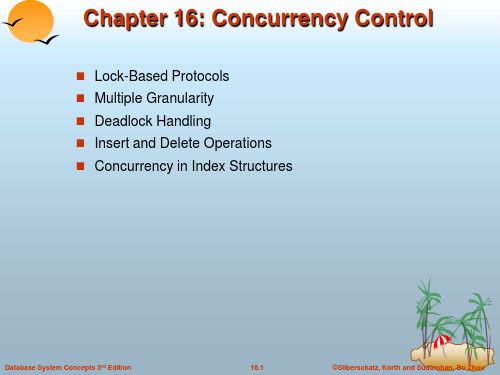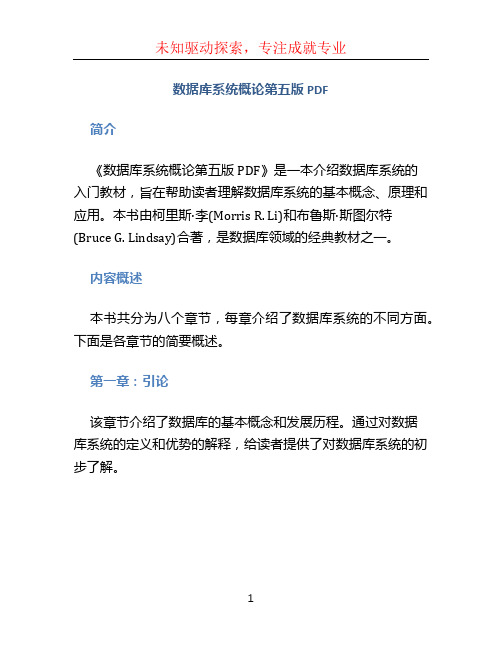浙江大学数据库系统概念PPT第十六章 对应原版教材第五版
浙江大学数据库系统概念PPT第十六章-精品文档28页

Database System Concepts 3rd Edition
16.1
©Silberschatz, Korth and Sudarshan, Bo Zhou
Lock-Based Protocols
A lock is a mechanism to control concurrent access to a data item Data items can be locked in two modes :
Basically, how to generate a correct (serializable) schedule?
Database System Concepts 3rd Edition
16.4
©Silberschatz, Korth and Sudarshan, Bo Zhou
Pitfalls of Lock-Based Protocols
T2: lock-S(A); read (A); unlock(A); lock-S(B); read (B); unlock(B); display(A+B)
Locking as above is not sufficient to guarantee serializability — if A and B get updated in-between the read of A and B, the displayed sum would be wrong.
数据库系统概念PPT第一章,对应原版教材第五版

Analogous to the value of a variable
Physical Data Independence – the ability to modify the physical schema
Security problems
Database systems offer solutions to all the above problems
Database System Concepts
1.5
©Silberschatz, Korth and Sudarshan, Bo Zhou
Data Abstraction
1.6
©Silberschatz, Korth and Sudarshan, Bo Zhou
Levels of Abstraction
A major purpose of database system is to provide an abstract of
view of data, and hide the certain detail of data storage.
Integrity constraints (e.g. account balance > 0) become part
of program code
Hard to add new constraints or change existing ones
Database System Concepts
without changing the logical schema
数据库系统概念原书第5版(英文)第二章PPT课件

9/29/2020
Dept. of Comp. Sci. & Tech.,
4
Example of a Relation
9/29/2020
Dept. of Comp. Sci. & Tech.,
5
Basic Structure
Formally, given sets D1, D2, …. Dn a relation r is a subset of D1 x D2 x … x Dn Thus a relation is a set of n-tuples (a1, a2, …, an) where
• Other Topics: XML, Distributed Databases, Advanced topics……
9/29/2020
Dept. of Comp. Sci. & TRelational Model for Databases Relational Algebra Operations
9/29/2020
Dept. of Comp. Sci. & Tech.,
2
Outline of the Course (2)
• Part 4 Data Storage & Querying
– Chapter 11: Storage and – Chapter 12: Indexing and Hashing – Chapter 13: Query Processing – Chapter 14: Query Optimization
1
Outline of the Course (1)
• Chapter 1: Introduction
Part 1 Relational Databases
浙江大学数据库系统概念PPT第十章,对应原版教材第五版

querying XML documents/data
Database System Concepts 10.5 ©Silberschatz, Korth and Sudarshan, Bo Zhou
Comparison with Relational Data
Inefficient: tags, which in effect represent schema information,
Nesting is supported in object-relational databases
But nesting is appropriate when transferring data
External application does not have direct access to data referenced by a foreign key
<bank-1> <customer> <customer_name> Hayes </customer_name> <customer_street> Main </customer_street> <customer_city> Harrison </customer_city> <account> <account_number> A-102 </account_number> <branch_name> Perryridge </branch_name> <balance> 400 </balance> </account> <account> … </account> </customer> . . </bank-1>
数据库系统概论第五版PDF

数据库系统概论第五版PDF简介《数据库系统概论第五版PDF》是一本介绍数据库系统的入门教材,旨在帮助读者理解数据库系统的基本概念、原理和应用。
本书由柯里斯·李(Morris R. Li)和布鲁斯·斯图尔特(Bruce G. Lindsay)合著,是数据库领域的经典教材之一。
内容概述本书共分为八个章节,每章介绍了数据库系统的不同方面。
下面是各章节的简要概述。
第一章:引论该章节介绍了数据库的基本概念和发展历程。
通过对数据库系统的定义和优势的解释,给读者提供了对数据库系统的初步了解。
第二章:关系数据模型该章节介绍了关系数据模型,包括关系模型的构成要素、关系数据库设计和关系代数。
通过对关系数据模型的详细介绍,读者可以理解关系数据库的基本原理和数据组织方式。
第三章:SQL语言该章节介绍了SQL语言,包括SQL的基本语法、数据的查询和修改操作。
通过对SQL语言的学习和实践,读者可以掌握数据库操作的基本技巧。
第四章:数据库设计该章节介绍了数据库设计的基本原理和方法。
包括数据模型的设计、关系模式的规范化和数据库的物理组织方式。
通过对数据库设计的学习,读者可以理解如何设计一个高效稳定的数据库系统。
第五章:数据库编程该章节介绍了数据库编程的基本概念和技术。
包括存储过程、触发器和函数的编写,以及数据库事务的管理。
通过对数据库编程的学习,读者可以掌握如何编写高效的数据库应用程序。
第六章:关系数据库标准化及数据完整性该章节介绍了关系数据库的标准化和数据完整性保证。
包括关系数据模式的规范化、实体完整性和参照完整性的实现。
通过对数据库标准化和数据完整性的学习,读者可以设计出符合标准和完整性要求的数据库系统。
第七章:物理数据库设计和调优该章节介绍了物理数据库设计和调优的基本原理和方法。
包括数据库索引的设计、查询优化和数据存储方式的选择。
通过对物理数据库设计和调优的学习,读者可以设计出高效的数据库系统和查询方案。
数据库系统概念原书第5版(英文)第一章ppt

August 15, 2013
Dept. of Comp. Sci. & Tech., Tongji Uni.
4
What is a database?
A very large, integrated collection of data
The amount of data is very large The data is structured and interrelated The data is integrated Entities (e.g., students, courses) Relationships (e.g., Li is taking Database and Knowledge) More recently, also includes active components (e.g. “business logic”)
浙江大学数据库系统概念十七,对应原版教材第五版

System crash: a power failure or other hardware or software failure causes the system to crash.
Consider transaction Ti that transfers $50 from account A to account B; goal is either to perform all database modifications made by Ti or none at all.
When transaction Ti starts, it registers itself by writing a <Ti start>log record
Before Ti executes write(X), a log record <Ti, X, V1, V2> is written, where V1 is the value of X before the write, and V2 is the value to be written to X.
Database System Concepts
17.7
©Silberschatz, Korth and Sudarshan, Bo Zhou
Implementation of Atomicity and Durability (Cont.)
The shadow-database scheme:
数据库系统概念原书第5版(英文)第一章PPT课件

9/29/2020
Dept. of Comp. Sci. & Tech., Tongji Uni.
4
What is a database?
A very large, integrated collection of data
The amount of data is very large The data is structured and interrelated The data is integrated
9/29/2020
Dept. of Comp. Sci. & Tech., Tongji Uni.
2
Outline of the Course (2)
Part 4 Data Storage & Querying
Chapter 11: Storage and Chapter 12: Indexing and Hashing Chapter 13: Query Processing Chapter 14: Query Optimization
recommendations Manufacturing: production, inventory,
orders, supply chain Human resources: employee records,
salaries, tax deductions
9/29/2020
Dept. of Comp. Sci. & Tech., Tongji Uni.
6
Database Management System (DBMS)
A Database Management System (DBMS) is
a software package designed to store and manage databases
浙江大学数据库系统概念PPT第十五章,对应原版教材第五版

Database System Concepts
15.5
©Silberschatz, Korth and Sudarshan, Bo Zhou
Concurrent Executions
Multiple transactions are allowed to run concurrently in the system. Advantages are:
Database System Concepts
15.1
©Silberschatz, Korth and Sudarshan, Bo Zhou
Transaction Concept
E.g. Transaction to transfer $50 from account A to account B:
T1 1 2 3 4 5 X = x+1 Write(x) X = x*2 Write(x) Read(x) Read(x) T2
Dirty Read:
T1 1 2 3 rollback Write(T) Read(T) T2
Database System Concepts
15.7
©Silberschatz, Korth and Sudarshan, Bo Zhou
Some notions:
Serial Schedule Equivalent schedule Serializable Schedule
(完整word版)数据库系统概论第五版

数据库系统概论第五版第1章绪论1 .试述数据、数据库、数据库系统、数据库管理系统的概念。
答:( l )数据( Data ) :描述事物的符号记录称为数据。
数据的种类有数字、文字、图形、图像、声音、正文等。
数据与其语义是不可分的。
解析在现代计算机系统中数据的概念是广义的。
早期的计算机系统主要用于科学计算,处理的数据是整数、实数、浮点数等传统数学中的数据。
现代计算机能存储和处理的对象十分广泛,表示这些对象的数据也越来越复杂。
数据与其语义是不可分的。
500 这个数字可以表示一件物品的价格是 500 元,也可以表示一个学术会议参加的人数有 500 人,还可以表示一袋奶粉重 500 克。
( 2 )数据库( DataBase ,简称 DB ) :数据库是长期储存在计算机内的、有组织的、可共享的数据集合。
数据库中的数据按一定的数据模型组织、描述和储存,具有较小的冗余度、较高的数据独立性和易扩展性,并可为各种用户共享。
( 3 )数据库系统( DataBas 。
Sytem ,简称 DBS ) :数据库系统是指在计算机系统中引入数据库后的系统构成,一般由数据库、数据库管理系统(及其开发工具)、应用系统、数据库管理员构成。
解析数据库系统和数据库是两个概念。
数据库系统是一个人一机系统,数据库是数据库系统的一个组成部分。
但是在日常工作中人们常常把数据库系统简称为数据库。
希望读者能够从人们讲话或文章的上下文中区分“数据库系统”和“数据库”,不要引起混淆。
( 4 )数据库管理系统( DataBase Management sytem ,简称 DBMs ) :数据库管理系统是位于用户与操作系统之间的一层数据管理软件,用于科学地组织和存储数据、高效地获取和维护数据。
DBMS 的主要功能包括数据定义功能、数据操纵功能、数据库的运行管理功能、数据库的建立和维护功能。
解析 DBMS 是一个大型的复杂的软件系统,是计算机中的基础软件。
浙江大学数据库系统概念

Failure Classification Transaction State A quick view of Log-Based Recovery
Database System Concepts
17.1
©Silberschatz, Korth and Sudarshan, Bo Zhou
Implementation of Atomicity and Durability
The recovery-management component of a database system implements the support for atomicity and durabie (Cont.)
Active, the initial state; the transaction stays in this state while it is executing Partially committed, after the final statement has been executed. Failed, after the discovery that normal execution can no longer proceed. Aborted, after the transaction has been rolled back and the database restored to its state prior to the start of the transaction. Two options after it has been aborted:
all updates are made on a shadow copy of the database, and db_pointer is made to point to the updated shadow copy only after the transaction reaches partial commit and all updated pages have been flushed to disk.
浙江大学数据库系统概念PPT-SQL2,对应原版教材第五版

Commercial systems offer most, if not all, SQL-92 features, plus varying features from later standards and special proprietary features.
Not all examples here may work on your particular system.
Database System Concepts
A little of physical 4.5 structure…
©Silberschatz, Korth and Sudarshan, Bo Zhou
Domain Types in SQL
char(n). Fixed length character string, with user-specified length n. varchar(n). Variable length character strings, with user-specified maximum length n. int. Integer (a finite subset of the integers that is machine-dependent). smallint. Small integer (a machine-dependent subset of the integer domain type). numeric(p,d). Fixed point number, with user-specified precision of p digits, with n digits to the right of decimal point. real, double precision. Floating point and double-precision floating point numbers, with machine-dependent precision. float(n). Floating point number, with user-specified precision of at least n digits. Null values are allowed in all the domain types. Declaring an attribute to be not null prohibits null values for that attribute.
《数据库系统概论》课件

数据挖掘是从大量数据中提取有用的信息和知识的过程。数据挖掘技术包括关联分析、聚类分析、分类和预测等 ,可以帮助企业发现隐藏在数据中的价值。
分布式数据库系统
• 分布式数据库系统是一种将数据 存储在多个物理节点上的数据库 系统,每个节点拥有自己的存储 系统和处理能力。分布式数据库 系统可以实现数据的分散存储和 访问,提高数据的可用性和可扩 展性。
数据库
存储数据的物理结构。
查询优化器
优化查询性能,选择最佳的查 询执行计划。
用户界面
提供用户与数据库交互的界面 ,包括命令行界面和图形用户 界面。
06
数据库技术的发展趋 势
数据仓库与数据挖掘技术
数据仓库
数据仓库是一个大型、集中式的存储系统,用于存储和管理大量的数据,以便进行查询、分析和决策支持。数据 仓库技术包括数据清理、数据集成、数据存储和查询优化等技术。
需求分析阶段需要与用户进行深入交流,了解用户的需求和业务场景,并 整理成需求文档。
需求分析阶段还需要对数据进行分类和分析,确定数据的来源、结构和关 系。
概念设计阶段
01 概念设计阶段是根据需求分析的结果,设计出满 足用户需求的数据库概念结构。
02 概念设计阶段主要采用E-R图等工具进行数据模 型的设计,确定实体、属性、关系等概念。
数据的独立性
数据库系统将数据与应用程序分离, 使得数据的修改和应用程序的更新相 互独立。
数据的共享性
数据库系统允许多个用户同时访问和 操作数据,实现数据的共享和协同工 作。
数据库系统的分类
关系数据库系统
基于关系模型的数据库系统, 使用表格形式存储数据,支持
SQL语言进行数据操作。
非关系数据库系统
- 1、下载文档前请自行甄别文档内容的完整性,平台不提供额外的编辑、内容补充、找答案等附加服务。
- 2、"仅部分预览"的文档,不可在线预览部分如存在完整性等问题,可反馈申请退款(可完整预览的文档不适用该条件!)。
- 3、如文档侵犯您的权益,请联系客服反馈,我们会尽快为您处理(人工客服工作时间:9:00-18:30)。
If a lock cannot be granted, the requesting transaction is made to wait till all incompatible locks held by other transactions have been released. The lock is then granted.
Database System Concepts 3rd Edition
16.2
©Silberschatz, Korth and Sudarshan, Bo Zhou
Lock-Based Protocols (Cont.)
Lock-compatibility matrix
A transaction may be granted a lock on an item if the requested lock is compatible with locks already held on the item by other transactions
A locking protocol is a set of rules followed by all transactions while requesting and releasing locks. Locking protocols restrict the set of possible schedules.
Basically, how to generate a correct (serializable) schedule?
Database System Concepts 3rd Edition
16.4
©Silberschatz, Korth and Sudarshan, Bo Zhou
Pitfalls of Lock-Based Protocols
Database System Concepts 3rd Edition
16.1
©Silberschatz, Korth and Sudarshan, Bo Zhou
Lock-Based Protocols
A lock is a mechanism to control concurrent access to a data item Data items can be locked in two modes : 1. exclusive (X) mode. Data item can be both read as well as
written. X-lock is requested using lock-X instruction. 2. shared (S) mode. Data item can only be read. S-lock is
requested using lock-S instruction. Lock requests are made to concurrency-control manager. Transaction can proceed only after request is granted.
Database System Concepts 3rd Edition
16.3
©Silberschatz, Korth and Sudarshan, Bo Zhou
Lock-Based Protocols (Cont.)
Example of a transaction performing locking:
T2: lock-S(A); read (A); unlock(A); lock-S(B); read (B); unlock(B); display(A+B)
Locking as above is not sufficient to guarantee serializability — if A and B get updated in-between the read of A and B, the displayed sum would be wrong.
and its locks released.
Database System Concepts 3rd Edition
16.5
©Silberschatz, Korth and Sudarshan, Bo Zhou
Pitfalls of Lock-Based Protocols (Cont.)
The potential for deadlock exists in most locking protocols. Deadlocks are a necessary evil. Starvation is also possible if concurrency control manager is badly designed. For example:
Chapter 16: Concurrency Control
Lock-Based Protocols Multiple Granularity Deadlock Handling Insert and Delete Operations Concurrency in Index Structures
Consider the partial schedule
Neither T3 nor T4 can make progress — executing lock-S(B) causes T4 to wait for T3 to release its lock on B, while executing lock-X(A) causes T3 to wait for T4 to release its lock on A. Such a situation is called aБайду номын сангаасdeadlock. To handle a deadlock one of T3 or T4 must be rolled back
